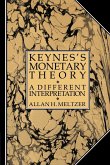This book makes Keynes's writings in his General Theory accessible to students by presenting this theory in a careful, consistent manner that is faithful to the original. Keynes's theory continues to be important, because the issues it raised, such as the problems of involuntary unemployment, the volatility of investment, and the complexity of monetary arrangements in modern capitalist economies, are still with us. Keynes's method of analysis, which tries to allow for the complications of dealing with historical time, deserves the careful attention given in this book. Keynes's formal analysis dealt only with a short period of time during which changes in productive capacity as a result of net investment were small relative to initial productive capacity. Roy Harrod and Joan Robinson were the two most prominent followers of Keynes who attempted to extend his analysis to the long period by allowing for the effects of investment on productive capacity as well as on effective demand. The careful examination of their writings on this topic is a natural complement to the presentation of Keynes's General Theory and makes clear the severe limitations on any use of equilibrium concepts in dealing with accumulation in models which try to observe Keynes's warnings about an unknowable future in the type of world we inhabit.
Table of contents:
1. Introduction; 2. Towards The General Theory; 3. The General Theory of Employment; 4. Consumption and investment; 5. Money, finance and the rate of interest; 6. Equilibrium, change and time; 7. Harrod and dynamic economics; 8. Robinson on the accumulation of capital; 9. Conclusion.
Table of contents:
1. Introduction; 2. Towards The General Theory; 3. The General Theory of Employment; 4. Consumption and investment; 5. Money, finance and the rate of interest; 6. Equilibrium, change and time; 7. Harrod and dynamic economics; 8. Robinson on the accumulation of capital; 9. Conclusion.








